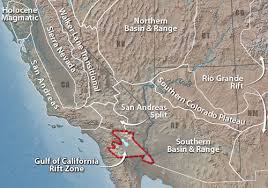Increase in seismicity around Salton Sea region linked to rifting of California
 October 27, 2012 – CALIFORNIA – Earthquake swarms and a region-wide rotten egg smell recently reminded Southern California residents they live next to an active volcano field, tiny though it may be. At the time, scientists said the phenomena did not reflect changes in the magma chamber below the Salton Sea. But now, researchers may need to revise estimates of the potential hazard posed by the Salton Buttes — five volcanoes at the lake’s southern tip. The buttes last erupted between 940 and 0 B.C., not 30,000 years ago, as previously thought, a new study detailed online Oct. 15 in the journal Geology reports. The new age — which makes these some of California’s youngest volcanoes — pushes the volcanic quintuplets into active status. The California Volcano Observatory, launched in February by the U.S. Geological Survey (USGS), already lists the area as a high threat for future blasts. “The USGS is starting to monitor all potentially active volcanoes in California, which includes the Salton Buttes,” said study author Axel Schmitt, a geochronologist at the University of California, Los Angeles. “With our results, I think this will further enhance the need to look into the system,” Schmitt told OurAmazingPlanet. The buttes exist because California is tearing apart, forming new oceanic crust as magma wells up from below. The sinking Salton Trough is the landward extension of the Gulf of California, and marks the boundary between the Pacific and North America tectonic plates. In August, an earthquake swarm shook the nearby town of Brawley. The USGS attributed the temblors to faults in the Brawley Seismic Zone. In September, a sulfurous stench emanated from the Salton Sea and wafted across the Inland Empire. The odor was tentatively linked to a fish die-off, but could also have been caused by volcanic gases, Stock said. –Yahoo News
October 27, 2012 – CALIFORNIA – Earthquake swarms and a region-wide rotten egg smell recently reminded Southern California residents they live next to an active volcano field, tiny though it may be. At the time, scientists said the phenomena did not reflect changes in the magma chamber below the Salton Sea. But now, researchers may need to revise estimates of the potential hazard posed by the Salton Buttes — five volcanoes at the lake’s southern tip. The buttes last erupted between 940 and 0 B.C., not 30,000 years ago, as previously thought, a new study detailed online Oct. 15 in the journal Geology reports. The new age — which makes these some of California’s youngest volcanoes — pushes the volcanic quintuplets into active status. The California Volcano Observatory, launched in February by the U.S. Geological Survey (USGS), already lists the area as a high threat for future blasts. “The USGS is starting to monitor all potentially active volcanoes in California, which includes the Salton Buttes,” said study author Axel Schmitt, a geochronologist at the University of California, Los Angeles. “With our results, I think this will further enhance the need to look into the system,” Schmitt told OurAmazingPlanet. The buttes exist because California is tearing apart, forming new oceanic crust as magma wells up from below. The sinking Salton Trough is the landward extension of the Gulf of California, and marks the boundary between the Pacific and North America tectonic plates. In August, an earthquake swarm shook the nearby town of Brawley. The USGS attributed the temblors to faults in the Brawley Seismic Zone. In September, a sulfurous stench emanated from the Salton Sea and wafted across the Inland Empire. The odor was tentatively linked to a fish die-off, but could also have been caused by volcanic gases, Stock said. –Yahoo News